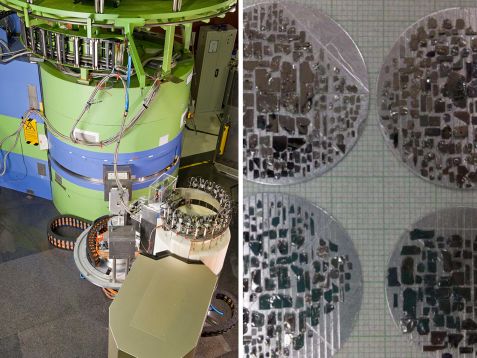MLZ is a cooperation between:
 > Technische Universität München
> Technische Universität München > Helmholtz-Zentrum Hereon
> Helmholtz-Zentrum Hereon
 > Forschungszentrum Jülich
> Forschungszentrum Jülich
MLZ is a member of:
 > LENS
> LENS > ERF-AISBL
> ERF-AISBL
MLZ on social media:

MLZ (eng)
Lichtenbergstr.1
85748 Garching
17.10.2016
Exploring the origins of high-temperature superconductivity

Left: At MLZ researchers use the cold three-axis spectrometer PANDA of JCNS to study the magnetic excitations associated with unconventional superconductivity. Right: Hundreds of tiny samples of unconventional superconductors known as heavy fermions had to be aligned and glued onto aluminium plates for imaging in inelastic neutron scattering experiments. © Eckert/Heddergott, Technische Universität München, Yu Song/Rice University
Since the discovery of high temperature superconductivity, researchers have tried to find out why these materials already become superconducting at comparatively high temperatures. Neutron scattering experiments at PANDA of the outstation of the Jülich Centre for Neutron Science (JCNS) at the Heinz Maier-Leibnitz Zentrum as well as at the NIST Center for Neutron Research (NCNR) in Gaithersburg, Maryland, USA, suggest a need to rethink the role of magnetic fluctuations in the formation of this phenomenon.
This kind of magnetic excitation occurs in all unconventional superconductors close to the transition temperature. Two models are being considered as possible causes; the outcome of the international team’s experiments are in good agreement with one of them.
Source: A. Wenzik / JCNS
Original publication:
Yu Song, John Van Dyke, I. K. Lum, B. D. White, Sooyoung Jang, Duygu Yazici, L. Shu, A. Schneidewind, Petr Čermák, Y. Qiu, M. B. Maple, Dirk K. Morr & Pengcheng Dai
Robust upward dispersion of the neutron spin resonance in the heavy fermion superconductor Ce1−xYbxCoIn5.
Nat. Commun. 7:12774 doi: 10.1038/ncomms12774 (2016).
News at Phys.org:
Neutron-scattering experiments explore origins of high-temp superconductivity, D. Ruth, 30.9.2016
MLZ is a cooperation between:
 > Technische Universität München
> Technische Universität München > Helmholtz-Zentrum Hereon
> Helmholtz-Zentrum Hereon
 > Forschungszentrum Jülich
> Forschungszentrum Jülich
MLZ is a member of:
 > LENS
> LENS > ERF-AISBL
> ERF-AISBL
MLZ on social media:


